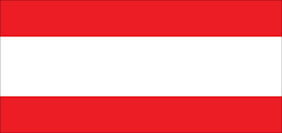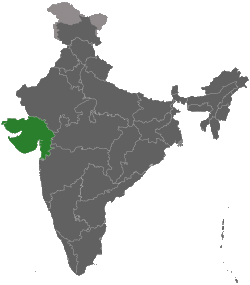India - Gujarat - Muslim Rule
 The Muslim rule in Gujarat lasted from their conquest of the province, shortly before the close of the thirteenth century AD, to their final defeat by the Marathas and loss of the city of Ahmadabad at the close of February 1758. Muslim historians generally tire the patience of the reader by too minute a detail of sieges and battles, of murder and intrigue, without relieving the fatiguing sameness of their narratives, by the more pleasing and instructive accounts of individual character, or the policy and domestic manners of a people.
The Muslim rule in Gujarat lasted from their conquest of the province, shortly before the close of the thirteenth century AD, to their final defeat by the Marathas and loss of the city of Ahmadabad at the close of February 1758. Muslim historians generally tire the patience of the reader by too minute a detail of sieges and battles, of murder and intrigue, without relieving the fatiguing sameness of their narratives, by the more pleasing and instructive accounts of individual character, or the policy and domestic manners of a people.
This whole term of Musalman ascendancy, stretching over slightly more than four and a half centuries, may conveniently be divided into three parts. The first, the rule of the early sovereigns of Delhi, lasting throughout almost the whole of the 14th century, or, more strictly from AD 1297 to AD 1403; the second, the rule of the Ahmadabad kings, a term of nearly one century and three-quarters, from AD 1403 to AD 1573; the third, the rule of the Moghal Emperors, when for little less than two hundred years, AD 1573-1760, Gujarat was administered by viceroys of the court of Delhi.
In the course of these 450 years, the limits of Gujarat varied greatly. In the fourteenth century A.d., the territory nominally under the control of the Musalman governors of Patan (Anhilvada) extended southwards from Jhalor, now in Rajputana, to the neighbourhood of Bombay, and in breadth from the line of the Msilwa and Khandesh hills, to the western shores of peninsular Gujarat. The earlier kings of Ahmadabad (AD 1403-1450), content with establishing their power on a firm footing, did not much extend the limits of their kingdom. Afterwards, during the latter part of the fifteenth and the beginning of the sixteenth centuries (AD 1450-1530), the dominions of the Ahmadabad kings became gradually wider, including to the east and north-east large tracts of territory formerly in the possession of the rulers of Khandesh and Malwa.
Again, during the time of misrule, which lasted from about AD 1530 to AD 1573, the western parts of Khandesh and the north of the Konkan ceased to form part of the kingdom of Gujarat. Finally, under the arrangements introduced by the emperor Akbar in A.d. 1583, more lands were restored to Malwa and Khandesh, and with the exception of Jhalor and Sirohi, Dungarpur and Bansv&da in the north, and Alirajpur on the east, since handed over to Rajputana and Central India, the limits of Gujarat remain almost as they were then laid down.
Gujarat's Muslim governor Zafar Khan Muzaffar asserted his independence, and established the first Muslim sultanate in Gujarat. He took advantage of the weak rulers of Delhi prevailing at the time. He declared independence and assumed the title of Muzaffar Shah. His successor, Ahmed I, the first independent Muslim ruler of Gujarat, found Ahmedabad in 1411 on the banks of the Sabarmati river.
 Prior to this, Mahmud of Ghazni invaded Gujarat, AD 1026. He had vowed to invade India in order to destroy idolatry, kill the kafirs, capture prisoners of war and plunder the vast wealth for which Gujarat was known. Later, Allaudin Khilji invaded Gujarat in 1298 AD.
Prior to this, Mahmud of Ghazni invaded Gujarat, AD 1026. He had vowed to invade India in order to destroy idolatry, kill the kafirs, capture prisoners of war and plunder the vast wealth for which Gujarat was known. Later, Allaudin Khilji invaded Gujarat in 1298 AD.
In March 1535 Chitor fell into the hands of the Gujarat king but his army was shortly afterwards routed by that of Humayun, emperor of Delhi. The Gujarat historians endeavour to throw the blame of Bahadur Shah's defeat on Rumi Khan, a foreigner, and a Turk, who was the head of the artillery, and who, they say, was a traitor; but there seems every reason to consider this an excuse, and that the Gujarat army was in both valour, discipline, and tactics inferior to the Moghals who defeated them. Bahadur Shah, unaccustomed to defeat, lost heart and fled to Mandu, which fortress was speedily taken by Humayun. From this the king fled to Champaner, and finally took refuge in Diu. Chatnpaner fell shortly to Humayun's efforts, and the whole of Gujarat, except Sorath, came under his rule.
Sultanate of Gujarat remained independent until 1576 when the Mughal emperor Akbar conquered it and annexed it to the Mughal Empire. The Mughal Emperor Akbar conquered Malwa and Gujarat in 1570s. The Mughals ruled for about 2 centuries till the streak was terminated by the Marathas in the mid 18th century. Chhatrapati Shivaji, the great Maratha ruler conquered Gujarat with his military skill.
With regard to the form of government under the Ahmadabad kings, Gujarat, as was later the case under British rule, was divided, politically, into two main parts. Of these, one, called the khdlsah or crown domain, was administered directly by the central authority; and the other, on payment of a certain tribute, in service or in money, was allowed to remain under the control of its former rulers. The amount of tribute paid by the different chiefs depended, not on the value of their territory, but on the terms granted to them when they agreed to become feudatories of the kings of Ahmadabad. This tribute under the Gujarat Sultans was usually collected by military expeditions headed by the king in person and these were called mxdkgiri or country-seizing circuits.
As far as the feudatory chiefs were concerned the internal management of their states was unaffected by the fact of their paying tribute. Justice was administered and the revenue collected in the same way as under the Anhilpur kings. The revenue consisted, as before, of a share of the crops received in kind, supplemented by the levy of special cesses, trade, and transit dues. The chief's share of the crops differed according to the locality, but rarely exceeded one-third of the produce, or was less than one-sixth. From some parts of his territory this share was realised directly from the cultivator by agents called mantris, while in other parts the collection was made through the medium of landowners of the superior class.
The portion of their territory under the direct authority of the Ahmadabad kings was divided into districts or sarkdrs. These districts were administered in one of two ways: they were either assigned to nobles in support of a certain contingent of troops, or they were set apart as crown domains and managed by paid officers. The officers placed in charge of districts set apart as crown domains were called maktda. Their chief duties were to preserve the peace.
The contests and disturbances, which, from the death of Aurangzib, AD 1707, to the defeat of the Mahrattas by Ahmad Shah Abdal�, AD 1761, tended gradually to destroy the prosperity of the province.
|
NEWSLETTER
|
| Join the GlobalSecurity.org mailing list |
|
|
|

